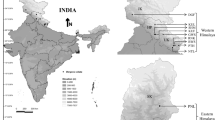Abstract
Tulipa (Liliaceae) has around 40–100 species throughout the world. The genetic diversity and population structure have not already been studied by different genetic markers. The present study aimed to evaluate the genetic diversity and population structure of some Tulipa species belonging to the subgenus Eriostemones based on CDDP technique. CDDP results indicated 204 polymorphic bands, thus, revealed a remarkable amount of polymorphism among studied tulips. The STRUCTURE analysis created two distinct clusters (K = 2). Molecular variance analysis displayed more genetic variation within populations (81%). Studied accessions are not well discriminated in distinct geographical groups.




Similar content being viewed by others
Availability of data and materials
All data are available in the manuscript or as Online Resources.
References
Aouadi M, Guenni K, Abdallah D, Louati M, Chatti K, Baraket G, Hannachi AS (2019) Conserved DNA-derived polymorphism, new markers for genetic diversity analysis of Tunisian Pistacia vera L. Physiol Mol Biol Plants 25:1211–1223
Botschantzeva Z (1962) Tulips. Taxonomy, morphology, cytology, phytogeography and physiology (Russian edn). English translation: Varekamp HQ (1982) Balkema, Rotterdam
Botschantzeva Z (1982) Tulips: taxonomy, morphology, cytology, phytogeogr. CRC Press
Botstein D, White RL, Skolnick M, Davis RW (1980) Construction of a genetic linkage map in man using restriction fragment length polymorphisms. Am J Hum Genet 32:314
Christenhusz MJ et al (2013) Tiptoe through the tulips–cultural history, molecular phylogenetics and classification of Tulipa (Liliaceae). Bot J Linn Soc 172:280–328. https://doi.org/10.1111/boj.1206
Collard BCY, Mackill DJ (2009) Conserved DNA-Derived Polymorphism (CDDP): a simple and novel method for generating DNA markers in plants. Plant Mol Biol Rep 27:558–562
Coşkunçelebi K, Terzioğlu S, Türkmen Z, Makbul S, Usta A (2008) A comparative study on two closely relative Tulipa L. taxa from NE Anatolia. Plant Syst Evol 276:191–198
de Reboul E (1847) Sulla divisione del genere Tulipa in sezioni naturali: Discorso. Societa Tipografica
Doležel J, Bartoš J (2005) Plant DNA flow cytometry and estimation of nuclear genome size. Ann Bot 95:99–110
Doyle JJ, Doyle JL (1987) A rapid DNA isolation procedure from small quantities of fresh leaf tissues. Phytochem Bull 19:11–15
Earl DA, vonHoldt BM (2012) STRUCTURE HARVESTER: a website and program for visualizing STRUCTURE output and implementing the Evanno method. Conserv Genet Resour 4:359–361
Eslami Farouji A, Khodayari H, Saeidi H, Rahiminejad MR (2015) Genetic diversity of diploid Triticum species in Iran assessed using inter-retroelement amplified polymorphisms (IRAP) markers. Biologia 70:52–60
Eslami Farouji A, Khodayari H, Assadi M, Özüdoğru B, Çetin Ö, Mummenhoff K, Bhattacharya S (2018) Numerical taxonomy contributes to delimitation of Iranian and Turkish Hesperis L. (Brassicaceae) species. Phytotaxa 367:101–119
Evanno G, Regnaut S, Goudet J (2005) Detecting the number of clusters of individuals using the software STRUCTURE: a simulation study. Mol Ecol 14:2611–2620
Govaerts R (2008) World checklist series, RBG Kew, UK: genus Tulipa
Haerinasab M, Ali-Farsangi F, Bordbar F, Eslami Farouji A (2020a) Genetic diversity and infraspecific relationships of Trifolium fragiferum L. in Iran. Iran J Sci Technol Trans A Sci 44:345–354
Haerinasab M, Karimian N, Jalilian N, Yousefi M (2020b) Evaluation of genetic diversity of some Iranian species in the genus Tulipa L. using CDDP molecular marker. Iran J Rangel for Plant Breed Genet Res (IJGPB) 28:1–16 ((in Persian))
Hajibarat Z, Saidi A, Hajibarat Z, Talebi R (2015) Characterization of genetic diversity in chickpea using SSR markers, Start Codon Targeted Polymorphism (SCoT) and Conserved DNA-Derived Polymorphism (CDDP). Physiol Mol Biol Plants 21:365–373
Hall D (1940) The genus Tulipa. The Royal horticultural society
Hammer Ø, Harper D (2006) Paleontological data analysis. Blackwell, Oxford
Jalilian N, Assadi M, Nemati M (2019) A contribution to the taxonomic delimitation of Tulipa armena (Liliaceae) and a key to the Iranian species. Feddes Repert 130:389–395
Jalilian N, Asadi M, Nemati Paykani M, Rahimi H (2021) Tulips as valuable ornamental plants in the flora of Iran. Iran Nat 6(1):45–56
Jiang L, Zang D (2018) Analysis of genetic relationships in Rosa rugosa using conserved DNA-derived polymorphism markers. Biotechnol Biotechnol Equip 32:88–94
Kiani M, Memariani F, Zarghami H (2012) Molecular analysis of species of Tulipa L. from Iran based on ISSR markers. Plant Syst Evol 298:1515–1522
Kimura M, Crow JF (1964) The number of alleles that can be maintained in a finite population. Genet 49(4):725
Kosenko V (1999) Contributions to the pollen morphology and taxonomy of the Liliaceae. Grana 38:20–30
Kritskaya TA, Kashin AS, Perezhogin YV, Murtazaliev RA, Anatov DM, Friesen N (2020) Genetic diversity of Tulipa suaveolens (Liliaceae) and its evolutionary relationship with early cultivars of T. gesneriana. Plant Syst Evol 306:1–15
Kron P, Suda J, Husband BC (2007) Applications of flow cytometry to evolutionary and population biology. Annu Rev Ecol Evol Syst 38:847–876
Kutlunina NA, Polezhaeva MA, Permyakova MV (2013) Morphologic and AFLP analysis of relationships between tulip species Tulipa biebersteiniana (Liliaceae). Russ J Genet 49:401–410
Kyseľ M, Žiarovská J, Štefúnová V, Ražná K, Švec M (2020) Marker profiling of wheat with different drought tolerance by CDDP. J Microbiol Biotechnol Food Sci 9:1220–1222
Lin X, Lou Y, Liu J, Peng J, Liao G, Fang W (2010) Crossbreeding of Phyllostachys species (Poaceae) and identification of their hybrids using ISSR markers. Genet Mol Res 9:1398–1404
Liu K, Muse SV (2005) PowerMarker: an integrated analysis environment for genetic marker analysis. Bioinformatics 21:2128–2129
Luan Q, Ouyang T, Jiang Y, Wang C (2008) Tulip RAPD analysis of cultivars and wild species in Xinjiang. Acta Agric Universitatis Jiangxiensis 30:656–660
Matin F (1998) Tulips of Iran. Agricultural Research, Education and Extension Organization (AREEO), Tehran
Najaphy A, Parchin RA, Farshadfar E (2011) Evaluation of genetic diversity in wheat cultivars and breeding lines using inter simple sequence repeat markers. Biotechnol Biotechnol Equip 25:2634–2638
Nei M (1973) Analysis of gene diversity in subdivided populations. Proc Natl Acad Sci U S A 70(12):3321–3323
Ocak A, Alan S, Ataşlar E (2004) Morphological, anatomical and ecological studies on Tulipa armena Boiss. var. lycica (Baker) Marais (Liliaceae). Turk J Bot 28:427–434
Peakall R, Smouse PE (2012) GenAlEx 6.5: genetic analysis in Excel. Population genetic software for teaching and research-an update. Bioinformatics 28:2537–2539
Poczai P, Varga I, Bell N, Hyvönen J (2011) Genetic diversity assessment of bittersweet (Solanum dulcamara, Solanaceae) germplasm using conserved DNA-derived polymorphism and intron-targeting markers. Ann Appl Biol 159:141–153
Potokina E, Vaughan DA, Eggi E, Tomooka N (2000) Population diversity of the Vicia sativa agg. (Fabaceae) in the flora of the former USSR deduced from RAPD and seed protein analyses. Genet Resour Crop Evol 47:171–183
Pourkhaloee A et al (2017) Genetic diversity and population structure of Iranian tulips revealed by EST-SSR and NBS-LRR Markers. Int J Hortic Sci Technol 4:167–182
Pourkhaloee A et al (2018) Molecular analysis of genetic diversity, population structure, and phylogeny of wild and cultivated tulips (Tulipa L.) by genic microsatellites. Hortic Environ Biotechnol 59:875–888
Pritchard JK, Stephens M, Donnelly P (2000) Inference of population structure using multilocus genotype data. Genetics 155:945–959
Raamsdonk L, Vries TD (1995) Species relationships and taxonomy in Tulipa Subg. Tulipa (Liliaceae). Plant Syst Evol 195:13–44
Raamsdonk L, Vries TD (1996) Cultivar classification in Tulipa L. (Liliaceae). Acta Bot Neerl 45:183–198
Rechinger K (1990) Tulipa L. Flora Iranica, Liliaceae2 Graz: Akademisch Druck-u Verlagsanstalt 194p, 165:76–77
Rohlf F (1997) NTSYS-pc version. 2.02 i numerical taxonomy and multivariate analysis system. Applied Biostatistics Inc., Exeter Software Setauket, New York
Santhosh W, Shobha D, Melwyn G (2009) Assessment of genetic diversity in cashew germplasm using RAPD and ISSR markers. Sci Hortic 120:411–417
Satıl F, Akan H (2006) Anatomical studies on some endemic and rare geophytes of Liliaceae Family. Ekologi 15:21–27 ((in Turkish))
Seyedimoradi H, Talebi R, Fayaz F (2016) Geographical diversity pattern in Iranian landrace durum wheat (Triticum turgidum) accessions using start codon targeted polymorphism and conserved DNA-derived polymorphism markers. Environ Exp Biol 14:63–68
Stork AL, Charpin A, Détraz C, Tsioli-Ray M, Tripod R (1984) Tulipes sauvages et cultivées. Conservatoire et Jardin botaniques de la Ville de Genève
Tang N, Shahin A, Bijman P, Liu J, van Tuyl J, Arens P (2013) Genetic diversity and structure in a collection of tulip cultivars assessed by SNP markers. Sci Hortic 161:286–292
Turktas M, Metin ÖK, Baştuğ B, Ertuğrul F, Saraç YI, Kaya E (2013) Molecular phylogenetic analysis of Tulipa (Liliaceae) based on noncoding plastid and nuclear DNA sequences with an emphasis on Turkey. Bot J Linn Soc 172:270–279
Van Raamsdonk L, De Vries T (1992) Biosystematic studies in Tulipa sect. Eriostemones (Liliaceae). Plant Syst Evol 179:27–41
Vvedensky A, Kovalevskaja S (1935) Tulipa Flora unionis rerumpublicarum sovieticarum socialisticarum 4:320–364
Wang X, Fan H, Li Y, Sun X, Sun X, Wang W, Zheng C (2014) Analysis of genetic relationships in tree peony of different colors using conserved DNA-derived polymorphism markers. Sci Hortic 175:68–73. https://doi.org/10.1016/j.scienta.2014.05.026
Wei Y-M, Hou Y-C, Yan Z-H, Wu W, Zhang Z-Q, Liu D-C, Zheng Y-L (2005) Microsatellite DNA polymorphism divergence in Chinese wheat (Triticum aestivum L.) landraces highly resistant to Fusarium head blight. J Appl Genet 46:3–9
Wendelbo P (1977) Tulips and Irises of Iran and their relatives. Botanical Institute of Iran, Botanical Garden, Tehran
Yanagisawa R, Kuhara T, Nishikawa T, Sochacki D, Marasek-Ciolakowska A, Okazaki K (2012) Phylogenetic analysis of wild and garden tulips using sequences of chloroplast DNA. Acta Hortic 953:103–110
Yeh FC, Yang RC, Boyle TB, Ye Z, Mao JX (1997) POPGENE, the user-friendly shareware for population genetic analysis Molecular biology and biotechnology centre, vol 10. University of Alberta, Edmonton, pp 295–301
Zonneveld BJM (2009) The systematic value of nuclear genome size for “all” species of Tulipa L. (Liliaceae). Plant Syst Evol 281:217–245
Acknowledgements
The authors would like to appreciate Payame Noor University for their financial support.
Funding
The study was funded and supported by Payame Noor University (Grant to M. Haerinasab).
Author information
Authors and Affiliations
Contributions
MH and NJ conceived the original idea and supervised the project. ZM carried out the experiment. AE helped analyze the data and write the manuscript with support from MH and NJ.
Corresponding author
Ethics declarations
Ethics approval
Ethical approval and responsibilities are compiled in this submission.
Consent to participate
All authors are consent to participate in this manuscript.
Consent for publication
All authors are consent for publication of this manuscript.
Conflict of interest
The authors declare that they have no conflict of interest.
Rights and permissions
About this article
Cite this article
Haerinasab, M., Molavi, Z., Jalilian, N. et al. Genetic Diversity and Population Structure of Some Iranian Tulipa Species Within the Subgenus Eriostemones Using CDDP Method. Iran J Sci Technol Trans Sci 45, 1273–1285 (2021). https://doi.org/10.1007/s40995-021-01144-x
Received:
Accepted:
Published:
Issue Date:
DOI: https://doi.org/10.1007/s40995-021-01144-x




